Fertilizing tomatoes in a greenhouse with boric acid

To get a large and high-quality tomato crop, the plants need to be fed regularly. Very often, gardeners use folk remedies to fertilize tomatoes grown in a greenhouse. One of these is boric acid, which is popular for its availability and effectiveness.
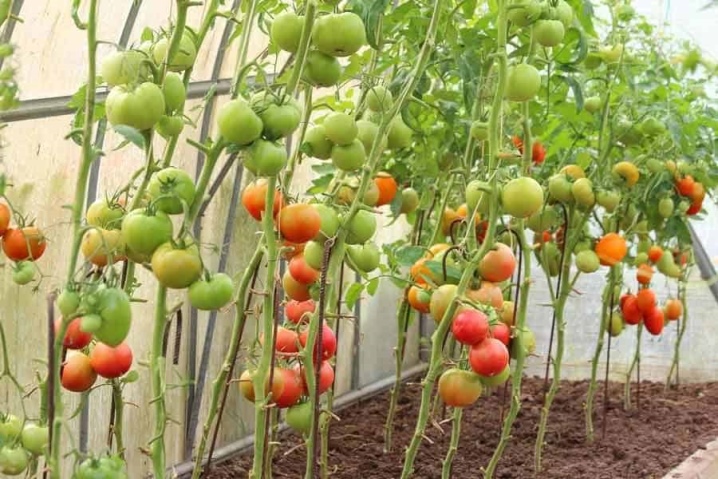
What is it for?
Boric acid treatment has many advantages. This product is capable of:
- increase seed germination;
- strengthen the immune system of plants;
- help form a healthy and strong root system;
- to intensify the growth of bushes, as well as to promote their active development;
- to increase the quantity and quality of ovaries;
- increase productivity several times;
- reduce the ripening period;
- increase the shelf life of tomatoes;
- protect plants from various pests, as well as from fungal diseases;
- improve the taste and aroma of tomatoes;
- protect plants from rot.
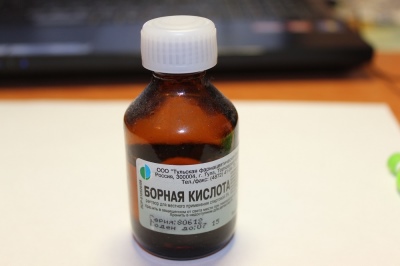
Since boron is not found in nature, the use of fertilizers that contain it in their composition has a positive effect on the condition of plants.
How often and when to deposit?
To achieve the desired result, you need to apply the dressing correctly. Tomatoes in the greenhouse are fertilized several times: after planting in the greenhouse, after the beginning of flowering and during fruiting.
After disembarking
Boric acid can be added during this period only if the seedlings were planted in depleted or sandy soil. In such soils, plants almost always lack boron. You can fertilize plants only 12-14 days after planting them in the beds.
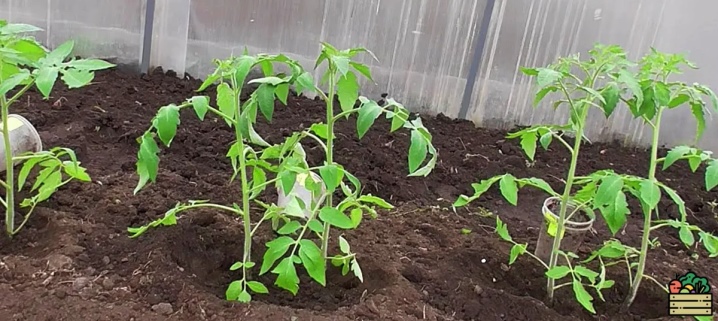
During flowering
The next stage of boric acid application falls on the initial stage of the growing season. It is best to spray the tomatoes during this period using the sprayer with the smallest holes. Processing should be carried out at a time when the buds have already formed, but have not yet opened.
At this stage, the plant can be fertilized 2-3 times, taking long breaks between dressings.
The advantage of boric acid is that it is absolutely safe for plants. Therefore, the treatment of bushes during the flowering period will not damage the crop.
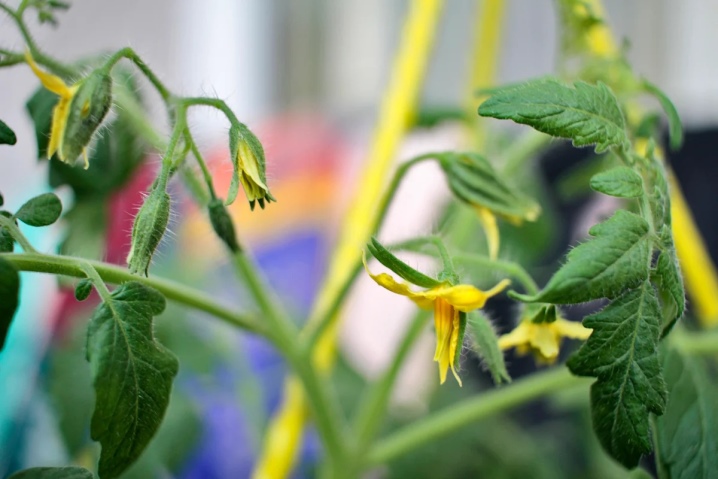
During fruiting
After the first fruits appear, the plants are also recommended to be sprayed with a boric acid solution. This will speed up the ripening of tomatoes, as well as protect them from pests and various diseases. It is recommended to use a mixture with boric acid early in the morning, even before the sun rises. On cloudy days, processing can be carried out at any time of the day.
In some cases, when plants lack boron, gardeners fertilize them several more times. The following signs indicate a lack of nutrients:
- the appearance of chlorosis on the leaves;
- a large number of lateral shoots that dry out quickly;
- fragility of the stems;
- weak fruiting;
- the color of the leaves is purple;
- mass drying of flowers;
- falling of fruits;
- the appearance of tomatoes of an unusual shape.
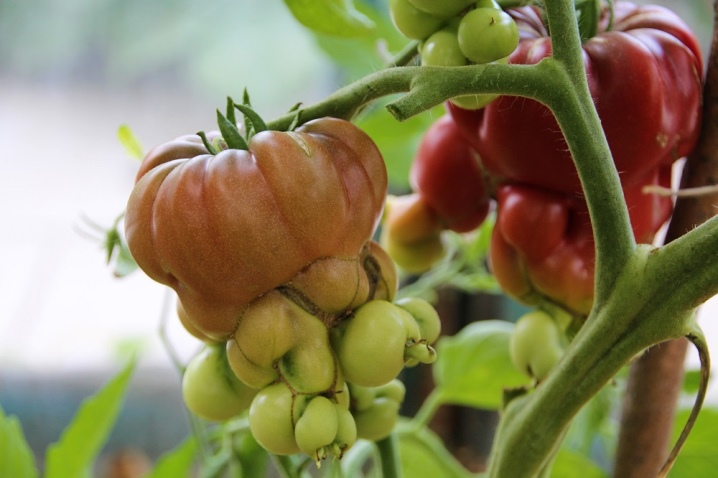
Having noticed these symptoms, the plants need to be additionally processed so that it does not die.
How to dilute?
It is very easy to make a boric acid solution. To prepare it, you must use warm or hot water.
There are several options for boron solutions that are very popular among gardeners.
Classical
A standard solution is prepared from water and boric acid. For 1 gram of dry product, you need to use 1 liter of boiling water. Stir the solution until the granules are completely dissolved. After that, it must be slightly cooled, and then poured into a sprayer or spray bottle and used to treat plants.
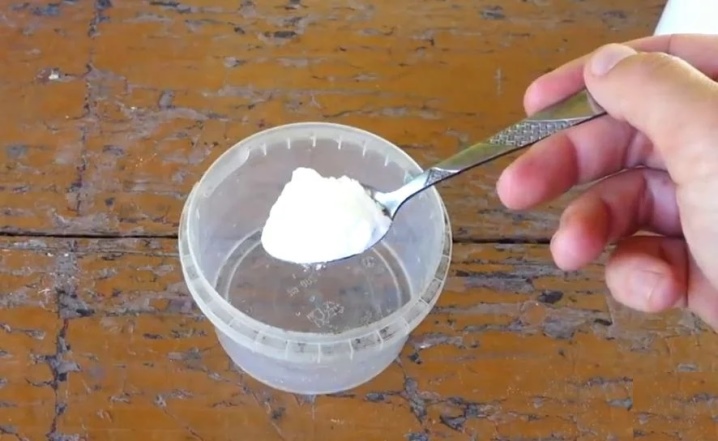
Boric acid solution from phytophthora
A disease such as late blight very often affects tomatoes. In order to protect your tomatoes from this disease, they must be treated with a special solution. To prepare it, you will need the following components:
- 10 grams of boric acid;
- 1 bucket of hot water;
- 20 ml of iodine;
- 1 liter of milk or whey.
It is not difficult to prepare a solution.
- First you need to pour boric acid with hot water and stir everything until smooth.
- Then pour milk and iodine there and mix everything again.
- The solution must be cooled to room temperature.
The mixture is then ready for use. You can spray 15-20 bushes with this solution.
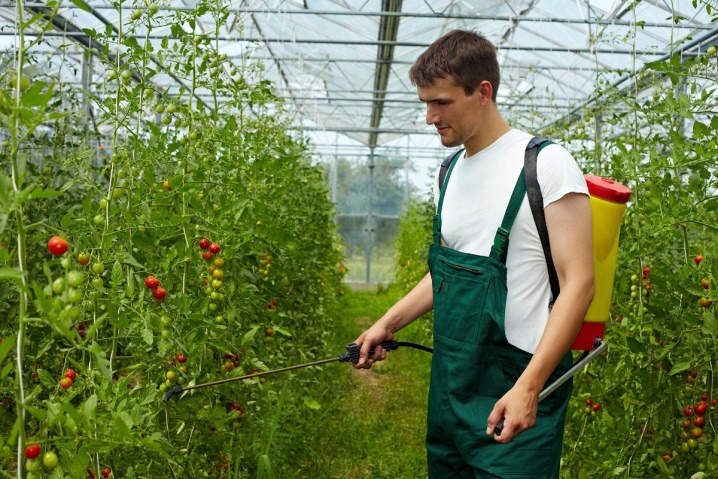
Pest solution
Quite often, tomatoes in greenhouses are attacked by various pests, for example, aphids. A mixture with the addition of the following components will help to cope with it:
- 1 gram of manganese;
- 4 tbsp. l. granulated sugar;
- 1 tbsp. l. boron;
- 25 drops of iodine;
- 10 liters of water.
The cooking method is as follows:
- first you need to dilute boric acid and potassium permanganate in hot water;
- when the mixture cools down, you need to add iodine and granulated sugar to it, and then mix everything thoroughly.
The prepared solution can be used for spraying. And in order to destroy ants, which are the main carriers of aphids, dry boric acid can be scattered in the aisles in the beds with bushes.
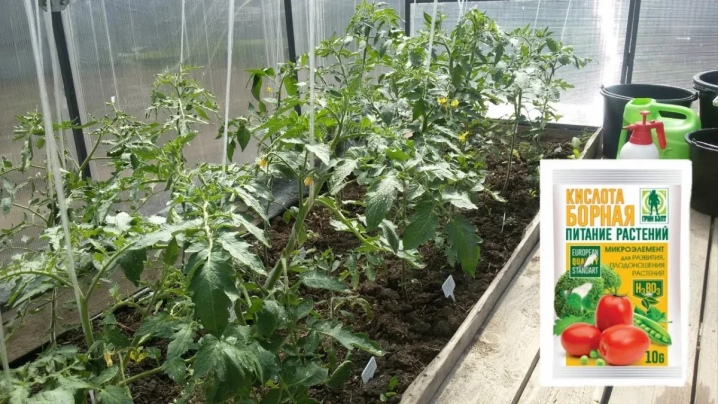
Mixture with ash and boric acid
Ash is very often present in top dressing recipes. It is very simple to prepare a mixture with this product and boric acid. The main thing is to observe all proportions. To prepare the solution you will need:
- 200 grams of ash;
- 3 liters of clean water;
- 1 tbsp. l. boric acid;
- 20 drops of iodine.
The preparation process will take some time.
- First, the ash must be poured into a glass jar and filled with water. The product should be placed in a warm place for several hours.
- After 48 hours, strain the mixture thoroughly.
- Boron must be diluted in hot water and poured out its ash solution. Iodine must also be added there. All this must be mixed well.
The ready-made solution can be used to feed the bushes.
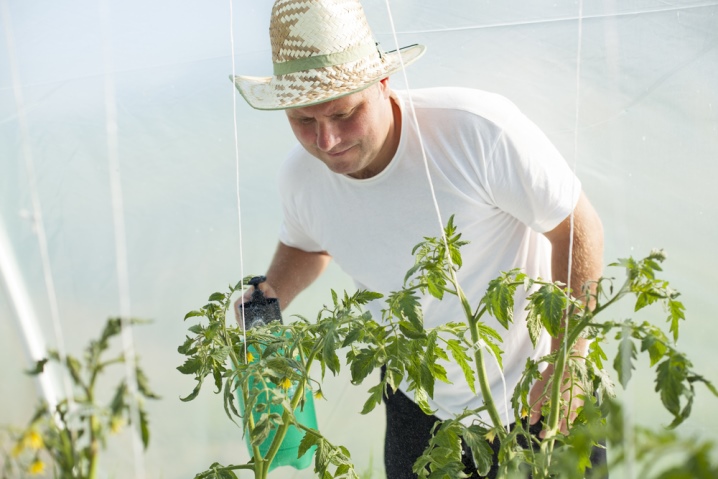
How to process?
Tomato processing can be done in different ways.
- Soaking tomato seeds. Gardeners often process the seeds before planting. This makes them more resistant to disease and weather conditions. This is done in two stages. The first time the seeds need to be treated with a mixture made from boric acid, 2-3 weeks before planting, and the second time - a day. In the process, the seeds in a gauze bag are simply dipped into the solution and kept there for 12-15 hours. For processing, it is best to use the simplest solution: 1 gram of boron per 1 liter of hot water. In order not to harm the plants, it is very important to observe the dosage.
- Top dressing when sowing seeds. It is recommended to fertilize the soil with boric acid solutions if the soil is very poor. A basic solution is used for soil cultivation. After applying it, the soil must be thoroughly loosened.
- Spraying tomatoes. You can feed adult plants by foliar method. This method is quite effective, because tomatoes very quickly absorb all the nutrients that fall on the leaves. Spraying tomatoes is best done with a small-hole sprayer. The solution should not be too strong so that the plants are not damaged during processing. Re-spraying must be repeated after a week. This method is also suitable at the time of plant pollination.
- Root processing. Many gardeners prefer to water their plants rather than spray them. But you have to be careful with this fertilization method. The best way to water your plants is to use a watering can.It is necessary to water the aisles, as well as all the land next to the plants. The ground part of the tomatoes should not be irrigated. The result of such feeding will not be visible as quickly as when spraying the plants.

In the process of preparing solutions with boric acid and treating plants with them, you should adhere to the following rules:
- work in rubber gloves, glasses and a respirator;
- prepare solutions in the open air;
- to process plants in dry and calm weather;
- process leaves from all sides;
- at the end of work, wash hands thoroughly with soap and water.
Boric acid is an excellent companion for tomato care. Using simple solutions based on it, even a novice gardener can increase the yield of their vegetables.

See the video for feeding tomatoes.













The comment was sent successfully.